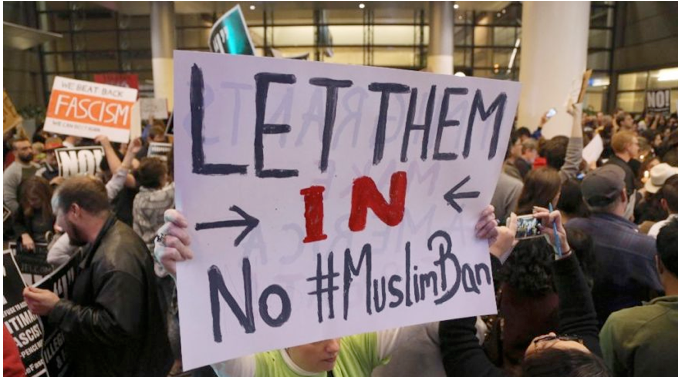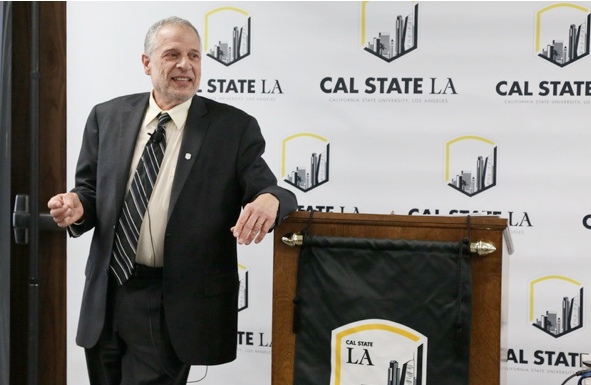CORRUPTION WATCH-President Donald J. Trump and his adviser Kellyanne Conway use “Alternative Facts,” which Meet the Press host Chuck Todd correctly identified as “Falsehoods.” In 2014, our own Judge Allan Goodman made the same observation about Eric Garcetti and his use of Alternative Facts when His Honor rejected Garcetti’s update to the Hollywood Community Plan. As judges often do, Judge Goodman used polite legalese, saying that Garcetti used “fatally flawed data” and “wishful thinking” -- which we know mean Lies and Myths.
How Lies and Myths and Alternative Facts crashed the economy in 2008.
Lies, Myths and Alternative Facts (LMAFs) resulted in the Crash of 2008 which devastated millions of Americans. The crash grew out of the ethos of Alternative Facts which originated from corrupt business practices right here in the Los Angeles area. Mortgage lenders like Countrywide and Indymac Bank were selling defective mortgages to Wall Street. (A defective mortgage is one in which the lender knows that the homeowner cannot pay off the loan and will default.) Wall Street would then bundle together defective mortgages and sell them to pension funds, foreign countries, etc. (Goldman Sachs executive and Trump’s Secretary of Treasury-designate Steven Mnuchin made his multi-million fortune by buying Indymac Bank after the Crash of 2008.)
We need to focus on how LMAFs crashed the economy in 2008 because, once again, they are at work both nationally and locally. Unless we stop this massive and near perpetual disinformation, life will become much worse for everyone.
Normally, a Wall Street investment firm like Goldman Sachs selling junk mortgages would result in investors not buying any more products; but the nature of defective mortgages was covered up by a second corrupt practice: The investment houses would guarantee the buyers that if the income from the bundled mortgages dipped below a certain amount, the investment firm itself would make up the difference. Thus, all those pension funds, foreign countries, etc. felt safe in buying the bundled mortgages.
However, there was a third level of fraud. The insurance sold by the investment houses to guarantee that the bundled mortgages would pay out the benefits was not insurance. Insurance should require the investment house to set aside insurance premiums to pay off the claims. Goldman Sachs et al were not putting those “premiums” into accounts so they would have the cash to pay future claims. Rather, they counted the premiums as regular income and spent the premium money. If State Farm spent all the premium money it collected, it would have no money to rebuild your home if it burned down. Likewise, when the investment firm spent all the “premiums” from the “insurance” it sold to buyers of the bundled, defective mortgages, it had no stock pile of cash to pay the claims.
Then, there was the fourth level of fraud. Insurance may only be sold to people with an insurable interest in a house or person. Thus, I cannot take out fire insurance on my neighbor’s house and my neighbor may not take out insurance on my life.
This is what occurred with bundled defective mortgages. Wall Street executives who created the defective bundles bought the “insurance” that would pay executives when their bundles failed. How long do you think you would be alive if MS-13 owned a $25 million dollar life insurance policy on your life? This is the criminal core of the Crash of 2008. Wall Street executives intentionally created defective bundled mortgages, then bought “insurance” on them. It’s the same as betting against a race horse you just drugged.
Since the bundles of defective mortgages had been designed to fail in order for the “insurance” to pay off, Wall Street executives started buying worthless mortgages from Countrywide, Indymac Bank and similar mortgage lenders. The faster the bundled defective mortgages failed, the sooner the Wall Street executives would collect on their “insurance.”
Because so many mortgages were being “sold,” the public erroneously assumed that people were buying all these new homes. Thus, billions of dollars were diverted to housing construction. All the mortgage companies wanted was a signature on a piece of paper, then they’d sell it to Wall Street with no regard as to whether the home “buyer” was employed or even existed. It got to the point that mortgage companies were inventing buyers and selling fake documents to Wall Street.
Wall Street executives did not care if homeowners could not afford the homes or that these homeowners were non-existent. The worse the mortgages became, the faster the bundles crashed and the faster the executives would put in their insurance claims. They called the insurance “credit default swaps” solely to evade any insurance regulations.
Because these Wall Street executives sold trillions of dollars of “insurance” on defective bundled mortgages, investment firms were faced bankruptcy unless one of two things happened:
(1) The U.S. government could immediately insure all mortgages.
Then no bundled mortgage would fail and no one could make a claim under the “insurance” (credit default swap.) No investment house would face failure as there would be no insurance claims based on defective mortgages. The cost to the government to start up such a program overnight could have been as high as $100 billion.
(2) The U.S. Government could bail out the Wall Street firms.
Using this approach, all the bundled mortgages would fail and Wall Street executives could collect their trillions of dollars through “insurance claims.” That is why the Obama-Geithner chose to bail out Wall Street – to make certain Wall Street firms had enough cash to pay off the crooks who had perpetrated the greatest economic crime in world history. Trillions of dollars flowed to Wall Street firms while Main Street went bankrupt. This corruptionism is also the origin of the Politics of Revenge that has brought us President Donald Trump.
Lies, Myths and Alternative Facts underlie the current LA housing market.
The current high prices for Los Angeles residential real estate is similarly based on Lies, Myths and Alternative Facts.
LMAF #1: There is no high demand for housing in Los Angeles.
Just as people incorrectly believed there was a huge demand for housing between 2002-2007 because it appeared that so many homes were being purchased, the high price of Los Angeles houses does not mean there is a demand for housing. As we learned in 2008 and forgot by 2009, crooks can manipulate markets thereby deceiving millions of people into believing there is a demand for housing. But there is always a crash.
LMAF #2: There is no single LA Housing market.
In reality, Los Angeles has several markets for homes and what happens in one housing market does not always affect another market. Each situation requires analysis based on real facts.
Families who want to buy a home in Echo Park are not driving up the cost for mansions in Bel Air. There is a stratification by price range for Los Angeles housing, but there is bleed over between nearby prices ranges. For example, after the City had 22,000 rent-controlled units destroyed and allowed judges to improperly eject poor people from their rent-controlled homes, four things resulted:
- Those people who could afford places in the next higher housing bracket bid up the rents for apartments which were just above the rent-control level.
- Those who could not afford to pay more than the low rent-controlled prices, e.g. the elderly and disabled on fixed income, became homeless. We do not add their rent of Zero Dollars to the cost of housing.
- Rental agencies reported that average rents had increased and used that biased data to raise rents.
- People believed that higher rents reflected an increased demand when in reality it reflected the fact that the Garcetti Administration reduced the supply of apartments for poor people by destroying rent-controlled housing.
The forces threatening Middle Class neighborhoods are more deceptively insidious.
As written in previous CityWatch articles, the worse threat to Los Angeles Middle Class is that homes are no longer valued by their value as Living Space but rather by their value as Speculative Investments. Because developers know that they can re-zone any property to anything that they want, they buy homes in lower priced residential areas where they plan to build two to eight houses on a single family lot.
The lot where the developer plans to put a Granny Flat is worth more to him as Speculation than it is worth to a family as Living Space. Because the developer knows that he can bribe his way to a Small Lot Subdivision, the price of the “family home” zooms into the stratosphere. A small parcel with 8 homes, each separated by 6 inches, is worth far more money to a developer than the family can afford.
A middle class family does not have to be in direct competition with a developer to be faced with a detached home’s Speculative Value. The realtor who sets the listing price researches recent sales prices for comparable homes. If two streets over, a home which was worth $300,000 for Living Space sold for $1.2 million on its Speculation Value, then the new home is priced at around $1 million even if the Living Space value is less than one third as much.
The evils which flow from residential properties’ prices being based on Speculative Value.
People, who pay attention to facts and the laws of economics, as opposed to Lies, Myths and Alternative Facts, know that certain evils always follow the “market dislocations” caused by LMAFs.
(1) The Middle Class moves away.
It’s a form of osmosis where upwardly-mobile middle class families move away from the High Cost, Low Opportunity cities like Los Angeles to Low Cost, High Opportunity cities like Nashville, Denver, or Austin, Texas. Los Angeles is already experiencing a significant net loss of its Family Millennials too this trend.
(2) The reduced demand for housing does not lower housing prices.
Prior to the Crash of 2008, there was virtually no demand for housing, yet the prices continued to increase. Mathematically, all financial frauds collapse; but until they do, prices show little or no indication of the bust that is a few months or weeks away. Prices remain high because they are based on the public believing the LMAFs. Eventually, however, people see reality and the crash arrives.
(3) Millions of homeowners who bought high are stranded in homes worth far less than the equity they have in those homes.
This drop in prices often wipes out families’ “nest eggs” since they have dumped all their cash into mortgages for homes which were inflated by two, three or four times of their true value by the Garcetti Administration’s disinformation. They can neither sell nor renegotiate these mortgages.
People who purchased homes based on inflated Speculative Values live in finance hell. They must continue paying these mortgages based on old values that are much higher than the new lower values. Since they dumped all their extra cash into their homes, they do not have adequate insurance or stocks, pensions or other investments. They are often “house poor” – with every cent tied up in the house. They just have to pray they can hold on until a better economy returns.
When the economy turns down, people are laid off. If a lay-off happens to a family that is “under water” with its mortgage, it may be headed for the streets. There will always be a kind and loving Steven Mnuchin ready to foreclose on that family, even if it was only 27 cents short in a payment.
The need for Residential Mortgage Insurance.
Since Obama-Geithner refused to institute Residential Mortgage Insurance (RMI,) once people are laid off, they needlessly lose their homes. Sure, they may find decent jobs – a year after their homes’ foreclosure -- but that’s of no help to them or the economy. Residential Mortgage Insurance is like fire insurance where the insurer makes up the short fall in the mortgage payment due to a financial disaster.
For example, if the Mom is laid off and the family lacks $1,500 on the $4,000 mortgage, the insurance pays the $1,500. This government insured program is good for the general welfare of the nation because it will stop a crash in the housing market like what happened in 2008. But Obama-Geithner thought a complete crash was preferable, and thus, they refused to institute RMI on even an emergency basis. Now, the nation is again vulnerable.
The Big Lie on which the LA residential housing market rests.
It is fraudulent to insist that there is demand for dense housing, that people want to live in mixed-use projects next to freeways, that people want Granny Flats or that people want to pay $850,000 to live in a house six inches away from another with no yard, no garden, no place for a dog, and no room for the kids to pitch a tent. Thus, we are paying taxes on billions of dollars of city bonds to construct the very type of dense housing which is emblematic of the fraud eating away at our economy.
We know that Garcetti is still feeding us a diet of Lies and Myths, just as we know that Family Millennials are moving away from LA to places where they can afford to buy a detached home with a nice yard with fruit trees and plenty of space. Worse yet, the decent employers are following the Family Millennials out of town.
(Richard Lee Abrams is a Los Angeles attorney. He can be reached at: [email protected]. Abrams views are his own and do not necessarily reflect the views of CityWatch.) Cartoon: LA Times. Edited for CityWatch by Linda Abrams.





 And that, you see, is where that big difference between 1968 and 2017 became apparent. Blocking a street or an intersection in 1968 was a whole different affair. An earlier generation remembers the police reading out the words, "This is an unlawful assembly." There was an official script that was colloquially referred to as "reading the riot act." Failure to disperse led to the police firing tear gas and, often enough, moving forward with clubs against the crowds.
And that, you see, is where that big difference between 1968 and 2017 became apparent. Blocking a street or an intersection in 1968 was a whole different affair. An earlier generation remembers the police reading out the words, "This is an unlawful assembly." There was an official script that was colloquially referred to as "reading the riot act." Failure to disperse led to the police firing tear gas and, often enough, moving forward with clubs against the crowds. 









 Said one participant, echoed by many, backed by so much pink: “There was an incredible politeness from the majority of the protesters. People were so close and I had never had so many boobs bump into me but everyone was saying ‘sorry’ and ‘excuse me.’ It was amazing! There was a variety of people there from old to young and of all races. The women who spoke were amazing. Janet Hahn was great and I think made us proud to be Angelenos.”
Said one participant, echoed by many, backed by so much pink: “There was an incredible politeness from the majority of the protesters. People were so close and I had never had so many boobs bump into me but everyone was saying ‘sorry’ and ‘excuse me.’ It was amazing! There was a variety of people there from old to young and of all races. The women who spoke were amazing. Janet Hahn was great and I think made us proud to be Angelenos.” 
 In 2008 a local developer won a referendum by 129 votes which granted a controversial building entitlement. The developer spent millions of dollars prior to the election with all manner of expensive propaganda. The grass-roots group opposing the developer’s plans suspected that many voters who had voted in Beverly Hills were not bona fide or legal residents of the City, but nonetheless voted in the election.
In 2008 a local developer won a referendum by 129 votes which granted a controversial building entitlement. The developer spent millions of dollars prior to the election with all manner of expensive propaganda. The grass-roots group opposing the developer’s plans suspected that many voters who had voted in Beverly Hills were not bona fide or legal residents of the City, but nonetheless voted in the election.



















